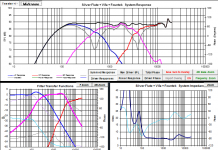Need a crossover for a center channel I want to build this summer.
See attached for a pic of the front baffle. Volume is likely to be 1-1.25 ft^3, sealed. Front baffle dimension is 8"x20" WxL.
Drivers are:
Vifa DQ25SC16-04
Fountek FR88EX
2x Silver Flute W17RC38-08
The unit will be below ear level but can be tilted up to have its forward axis meet the ears.
Not looking to spend too much, as you can see from the driver selection. I am OK with steel-core inductors but would prefer poly caps. I expect the crossover points should be somewhere around 2 kHz and 400 Hz. Slopes are up to you.
Isn't the center channel mostly for voice? The bandwidth on that is something roughly like 100Hz - 3000Hz. You could keep it simple and use a single 4" or 5" extended range driver with no crossover. Tang Band makes some reasonably priced full range drivers that would work well. IMO I don't see a need to make a complicated 3-way for the center channel...
-Charlie
SPL and off-axis response.Isn't the center channel mostly for voice? The bandwidth on that is something roughly like 100Hz - 3000Hz. You could keep it simple and use a single 4" or 5" extended range driver with no crossover. Tang Band makes some reasonably priced full range drivers that would work well. IMO I don't see a need to make a complicated 3-way for the center channel...
-Charlie
The W17RC38-04 is on Zaph's page. Would it make any sense to use this instead of the -08 version?Mid and tweet are from zaph, woofer from manufacturer.
Are you able to generate polars (horizontal and vert) with your software?
Thanks
Will it affect the crossover components or the system sensitivity?If you wanted to use the 04 version I could modify the design for it, it would be more accurate. The sim will be very close as is though.
No I cant generate polars.
Is the tweeter HP at 3700 Hz because the crossover becomes simpler? Or is it because the response is easier to keep smooth?
Sorry for all the questions.
Will it affect the crossover components or the system sensitivity?
Is the tweeter HP at 3700 Hz because the crossover becomes simpler? Or is it because the response is easier to keep smooth?
Sorry for all the questions.
Sensitivity might be a challenge, might lead to crossing the woofers over a lot higher.
The mid/tweet crossover was where phase, smooth response, and acceptable impedance all lined up the best. Trying to force a lower xover with a smooth response caused the impedance to drop very low. This is the benefit to having a very small/clean mid with tight CTC spacing, there isnt a negative to crossing this high.
The 69 uf cap wont make a difference. DCR is fairly important, depending on the location. Everything is spec'd for the DCR of 20ga air cores except for the woofer. You could use a lower DCR part for the 3.9mh inductor on the mid without much change. I wouldnt mess with any of the other inductors. Here is the response exactly as spec'd (with the 69uf cap).
An 18ga iron core on the woofer will raise its level another db.
An 18ga iron core on the woofer will raise its level another db.
Attachments
That will work. Are you combining smaller values for cost saving?
Make sure you follow Zaph's advice for mounting the driver
Make sure you follow Zaph's advice for mounting the driver
This is without a doubt the highest performing 3" I've come across, at least on a few fronts. The motor is an underhung neodymium design and the cone is thin (and fragile) formed aluminum. The only negative is a slightly ragged top end that may take some filter work if used full range, but I'd generally recommend a cheap and small neo tweeter placed close and crossed over high. There's a lot on the positive side, like high sensitivity, a clean low end and smooth midrange response. The frame is cast with ventilation under the spider, but users will have to pay close attention to airflow behind the cone - It's even more important to chamfer the inside baffle opening and in this case likely use a thinner baffle material as well.
Last edited:
Yes, somewhat. Solen's polyester series is cheaper than the series you picked (probably MKP) but they didn't have the exact values required, so I needed to parallel smaller caps to get the right values.
I am going to chamfer away as much as I can. I needed to do the same for some Hi-Vi B3S drivers I had, too.
I am going to chamfer away as much as I can. I needed to do the same for some Hi-Vi B3S drivers I had, too.
The response graph you're looking at is what, +/- 1.5dB? There's little point in analyzing the little bumps in that. The real question is how close Jay's estimates on the acoustic offsets end up being and (relatedly) whether the overall power/polar response ends up being a voicing you like in-room.
- Status
- This old topic is closed. If you want to reopen this topic, contact a moderator using the "Report Post" button.
- Home
- Loudspeakers
- Multi-Way
- Design me a crossover and I'll build it
